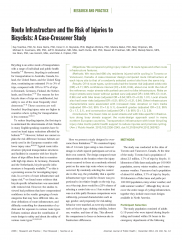Route Infrastructure and the Risk of Injuries to Bicyclists: A Case-Crossover Study
Document types:
Document weight:
Document geography:
Geographical spread:
Objectives. We compared cycling injury risks of 14 route types and other route infrastructure features.
Methods. We recruited 690 city residents injured while cycling in Toronto or Vancouver, Canada. A case-crossover design compared route infrastructure at each injury site to that of a randomly selected control site from the same trip.
Results. Of 14 route types, cycle tracks had the lowest risk (adjusted odds ratio [OR] = 0.11; 95% confidence interval [CI] = 0.02, 0.54), about one ninth the risk of the reference: major streets with parked cars and no bike infrastructure. Risks on major streets were lower without parked cars (adjusted OR = 0.63; 95% CI = 0.41, 0.96) and with bike lanes (adjusted OR = 0.54; 95% CI = 0.29, 1.01). Local streets also had lower risks (adjusted OR = 0.51; 95% CI = 0.31, 0.84). Other infrastructure characteristics were associated with increased risks: streetcar or train tracks (adjusted OR = 3.0; 95% CI = 1.8, 5.1), downhill grades (adjusted OR = 2.3; 95% CI = 1.7, 3.1), and construction (adjusted OR = 1.9; 95% CI = 1.3, 2.9).
Conclusions. The lower risks on quiet streets and with bike-specific infrastructure along busy streets support the route-design approach used in many northern European countries. Transportation infrastructure with lower bicycling injury risks merits public health support to reduce injuries and promote cycling.
(Am J Public Health. 2012;102:2336–2343. doi:10.2105/AJPH.2012.300762)
"Cycle tracks", the routes with lowest risks, are defined as "Paved path meant for cyclist use alongside major streets, separated by a physical barrier (e.g., a curb or bollards)".

